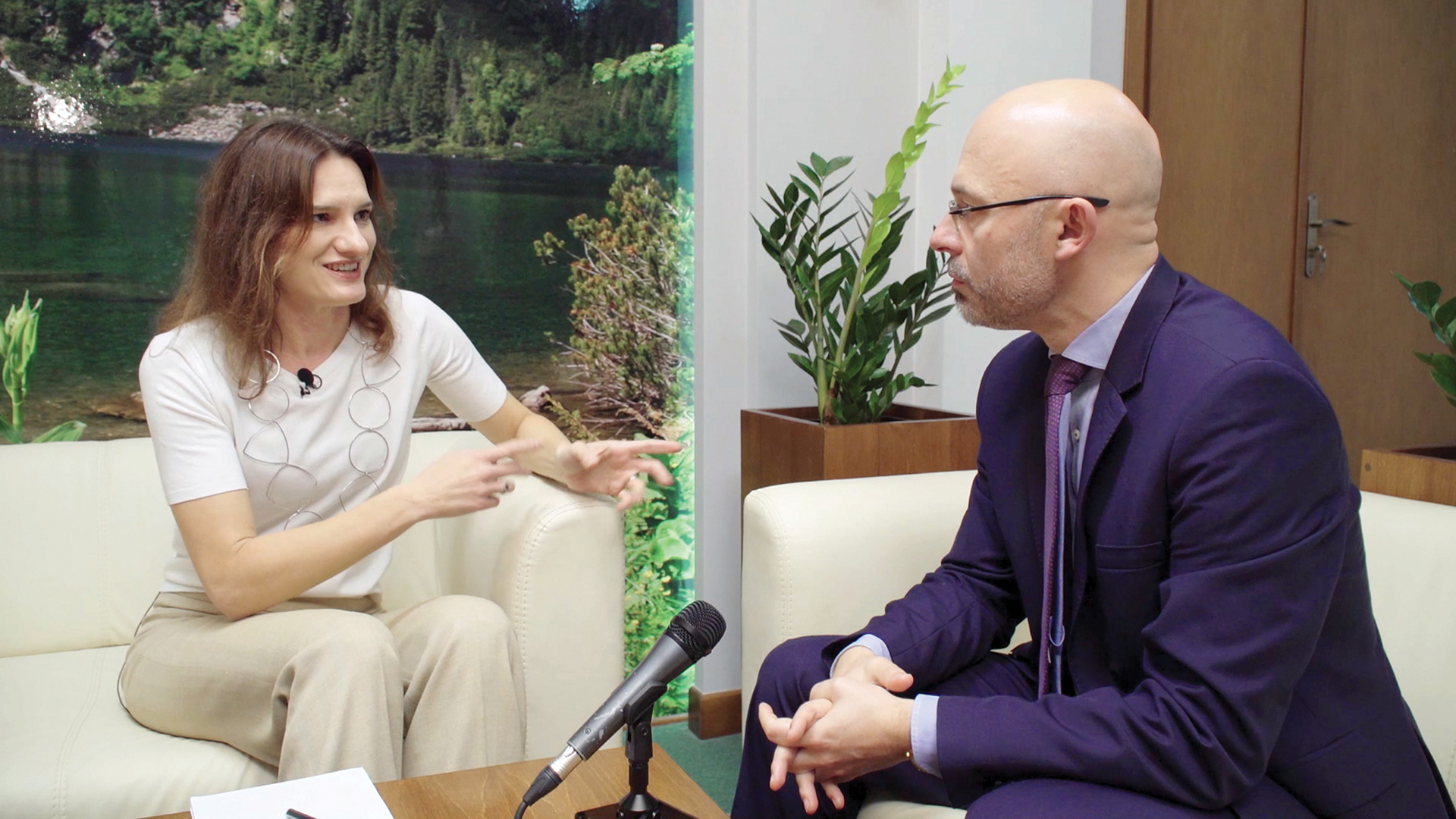Former CEO of PGE Baltica*
Michał Kurtyka: I am very happy to have Monika Morawiecka, Head of Strategy at PGE Polska Grupa Energetyczna with us today. Monika not only presents the beautiful face of Polish energy but is also very competent, very professional and has very far reaching views on how we can imagine the world in 2050 – as we have already discussed a couple of times. So, Monika, my first question will be an easy one to start the discussion: what will the energy world look like in 2050?
Monika Morawiecka: First of all: thank you very much for the invitation for such an interesting discussion and definitely a challenging question. The short answer to that question would be: I don’t know. The longer answer to the question says more about what I would like to see and not necessarily what I believe is possible. What I think would be nice to have in 2050 would be a world exclusively powered by renewable energy. Not just because of the climate issue, which is, of course, at the forefront of this, but also because it is just such a nice idea to be able to generate electricity without using any fuel at all. When I am talking renewable, I am talking about wind and sun, wave, tidal, maybe more. And because I am also an optimist at heart I think that people, humanity, is ingenious enough to be able to reach these goals. I am not sure if it will be possible by 2050, but I would definitely like to see that.
MK: So we can somehow imagine the end result, regardless of whether it will be 2050 or later, which is, of course, still far from where we are today. But you are talking about ingenuity and creativity. Today the big problem with wind and solar is that when the wind stops blowing and the sun stops shining we have lack of energy. So where do you expect to see the salvation?
MM: Here, of course the answer is pretty simple. Everybody says that the key to achieving that goal is solving the “storage issue”. And of course on the way to solving the storage issue, we can see many different technologies coming along: be it batteries – simple lithium-ion batteries, be it some other advanced or less advanced solutions – like other battery technologies with more potential. It could be hydrogen – the whole hydrogen economy could also play an important role, not only as a replacement for natural gas, but also by storing electricity produced by these solar and wind farms. So, of course, this is like the Holy Grail – if we manage to solve the issue of large scale long-term storage technology, then we can really say that it is possible to achieve the 100% renewable goal. This is what I think is possible. If we do not move as fast or as far as needed with storage technologies, then I think there is a big potential for a real revival of nuclear technologies in the future. If we decide together – not just in the EU – but as the World, to really completely stop using coal and natural gas for electricity generation, if we want to achieve zero emissions, and we still do not have these large scale storage technologies, then the only answer, looking at today’s world, is nuclear.
That is a challenge because we are aware of the current problems with large scale nuclear power, and we know that there are not many countries currently investing in moving this technology forward. We are aware of hope connected to the smaller scale nuclear technologies – the SMRs, small modular reactors – but there investment is also limited. It is limited in comparison to what is happening in renewables. So coming back to expected salvation, I think it is really a question we cannot answer right now.
MK: But there is some kind of technological gamble on both sides: either it will be on the side of storage or we are talking about nuclear. As far as I look at the market, the problem with large scale nuclear power plants, in the EU at least, is that the security concerns are so high that the costs are ever higher and, taking into account today’s prices of gas, for example in the US, it is not competitive. So people are not investing in this technology. What would have to happen for large scale nuclear power to make them come back locally? It is booming in other parts of the world and many countries are currently developing nuclear power – what about us? Earlier, you mentioned small-scale nuclear development which is a very promising, very interesting field. On the one hand, it is an insufficiently exploited area, but on the other, there are no economic triggers – no economic incentives to move it forward. What would need to happen in order to boost these technologies?
MM: An easy answer would be to change the perception of the technology among societies, in general. In particular, to change the approach of one particular society – the German society – which is an important influencer shaping the view of the rest of the world. Germans said a hard “No” to any nuclear projects in the future. It is actually interesting to watch what would happen there now. Very ambitious for emission reductions targets, for renewable capacities, without zero emission backup technology are difficult to achieve as we see it now.
MK: But the same discussion is going on in Japan after Fukushima – whether or not we are ready for the reopening of nuclear power plants, etc. So on the one side you think: yes, there will be some development on nuclear, on the other, you see a resentment globally.
MM: There might be bigger development in nuclear investments, if we do not move fast enough with storage, that is my guess. If we do move fast enough – then probably not, because it will be cheaper and less risky to develop renewables (plus storage) than to develop nuclear. Nuclear is such a challenging technology! These are very difficult and demanding projects to develop, very long in implementation – and also single-type projects. When you build a 1,000 MW offshore wind project, you build a 100 of identical turbines, 10MW each. It is much easier technologically – than to build a 1,000MW nuclear unit – because it is a repetitive, factory-based production. Nuclear is really complicated and I actually think it is one of the greatest achievements of mankind: nuclear technology put to use for energy production.

MK: What would be the main drivers of this switch to renewables or nuclear? Because it will be cheaper? Because it will be more accepted by societies? Because it will be regulated? Because new flows of money will be directed to this? What is your opinion on that?
MM: Of course, in the past it was mostly driven by regulations. In the EU and elsewhere, regulatory pressure towards decarbonization and towards mandating some growth in renewables were the driving forces behind it. But it is changing. And it is changing quite quickly. We have to credit this change to the regulatory pressure, because it jump-started the technology, mandating its development. Technological advancement came in because of the investment scale achieved. And now these technological advancements – which means lower costs – are a much more important driver than regulations and regulatory issues. Already around Europe you can see wind and solar could be competitive without subsidies.
MK: So regulations contributed to building the critical mass and right now it starts to be economical and it will go on like that.
MM: Yes, now it starts to be economical and I think we have not seen the end yet, the end of technological advancements in these technologies, so they are still improving and still lowering the cost.
And now the third issue, apart from regulations and technology, is a social pressure. Let’s take an example from my backyard. PGE as a large utility sells power to big industrial clients and what we see is more and more clients coming to us and asking for green electricity. The reason they are giving for that is interesting. They say: we do not care that much (about climate change), but we are large exporters (Poland is quite a big exporter of goods abroad), we have clients all over the world and they are asking us about our carbon footprint. They say, well, we would not buy from you anymore if you do not show us your green credentials. And why are they asking for that? Because their societies, their clients back home are asking for that. So this pressure is a global pressure. I think it is happening more and more often: a global pressure, social pressure and what used to be a CSR exercise for companies, is now more and more a question of this famous “to be or not to be”.
MK: Being able to respond to this social demand is the core activity of the company and not only a PR activity anymore.
MM: Yes, and we can, of course, question whether this will continue. Maybe the world will change and people will not care anymore? But why would they? It’s difficult to see where that change would come from, because if the costs are going down there is no argument anymore: oh, yes, nice, I like to go green but it is too costly. If it is not too expensive anymore, it is not an argument.
MK: We can try to imagine the future, though it is questionable as we discussed the time horizon of 2050. It is the symbolic moment. We can imagine a future in terms of energy without coal, without gas. Can we imagine a world without oil?
MM: Absolutely, yes. Electromobility and hydrogen mobility is around the corner. I think it is probably even more important to see that is happening sooner than switching to green electricity, because in large cities we breathe air that is polluted by cars. And more and more people in the world live in big cities, so it is becoming a serious problem for the health and well-being of the society. It is difficult to indicate which technology is more important, whether it is pure electric vehicles or whether we should concentrate more on hydrogen. Hydrogen mobility has the advantage of the energy storing option and it is relatively easy to transport. I think it is going to happen and it should definitely happen as soon as possible for everybody’s sake.
MK: I think that this dilemma about electric and hydrogen does not need to be resolved right now, because an electric car is, in fact, very similar to a hydrogen vehicle. The batteries are replaced with a hydrogen tank and it can move on basing on the same construction.
MM: Absolutely, and we have the same situation now when we have both petrol and diesel vehicles, so we can have electric and hydrogen cars.
MK: It is very interesting that we can also imagine a world without oil and you said that it can happen even faster as electromobility right now is booming.
MM: In transport, only in transport, because I’m not so sure about chemistry and plastics.
MK: Yes, the petrochemical industry is growing in terms of use.
MM: Exactly, that is another story. Although, of course, cutting back on plastic is also a burning issue. Here in the Ministry of Environment we know that this is important and that you can also reduce the future use of oil if you solve the plastic issue. I think oil is also limited in time.
MK: Do you think that there is some kind of relationship or coupling between transport and energy, because the common denominator between the two is the cost of storage, whether we store electricity in batteries, whether we store hydrogen, but at the end of the day it is interesting to see the two sectors converging through a very strategic common denominator.
MM: A little bit like an alliance. I think it is not only just the storage issue but also demand management issue. We know that electric vehicles can be used sort of both ways. They will for example use the excess energy from wind power for charging but they can also return some electricity, when needed, back to the grid. So I think this symbiosis, or whatever we call it, will exist and, of course, a big enabler for that to happen is the digitalization of both sectors. New business models are on.
MK: Let me be a bit “devil’s advocate” here as we are here in Poland, in Warsaw which, right now, is a very dynamically growing country, growing city, so when we talk about digitalization, when we talk about the switching of fossil fuels, it is in a certain context. However, when you look at, for example, the urbanization challenge of the world right now, and the enormous growth of cities in Asia, Africa, Latin America, there is a different economic context. Would it apply same to, let’s say, New Delhi as to Warsaw? Would the same reasoning be valid where you have, here in Warsaw, 500 cars per 1000 inhabitants, and in India with an average of 50, and people want to develop new forms of mobility? There is an appetite for growth, there is great economic development which is happening right now. Can we compare the two and can we apply the same solutions?
MM: We could have asked the same questions about Poland 30 years ago. Poland vs France, Warsaw vs Paris, whether we could compare and see the same development path. Thirty years ago, we would have said: “no”, “maybe not”, some optimist would have said: “yes”. Now we see it is comparable. As I said: I am an optimist, so in my opinion the world is developing at a pace which would allow many more people feel as privileged as we are here in Warsaw today or around Europe in general. So I think the short answer would be: yes, but I also think that the ways we develop will be a little bit different. Maybe it will be better in the future in these developing cities than here in Europe where you have 2-3 cars per family. Maybe we are talking about more changes than just a change of fuel in terms of mobility.
MK: Absolutely, that is the switching from individual to public transport, for example.
MM: So maybe we will be smarter than in the past.
MK: True and there is also a lesson of optimism to be learnt around the planet, because we can share experiences, we can build on successes but also on failures in order to also help the developing world to have some potential for leapfrogging.
MM: Yes, and learning from other people’s mistakes. That is always the best.
MK: That is a great vision. Thank you very much Monika. Not only for this optimistic but also very interesting approach. Thank you very much for this discussion.
MM: Thank you.
*The interview comes from the book “The Future of Energy” published in 2019 by the Bureau of the COP24 Presidency of the Ministry of Climate and Environment of the Republic of Poland













